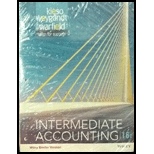
Lease: A contractual arrangement between the owner of the asset and the user of the asset for a fixed amount of money is termed lease. In this contract the owner of the asset permits the user to use the property for a fixed sum of money received at the time of handing over the asset. At the end of the contract tenure the user of the asset need to return the asset to the owner. The parties involved in the contract are termed the lessor the owner of the asset and the lessee the user of the asset.
(a)
To determine the type of lease to B Company.
(b)
To determine the present value of the minimum lease payment.
(c)
To record: To record the lease inception in the journal.
(d)
To record: To record the
(e)
To record: To record the first month lease payment.
Want to see the full answer?
Check out a sample textbook solution
Chapter 21 Solutions
Intermediate Accounting 16E Binder Ready Version With Wiley Plus Blackboard
- What is the net realizable value (nrv) of account receivable? General accounting questionarrow_forwardMurdock Corporation's July 31 bank reconciliation shows deposits in transit of $1,800. The general ledger Cash in Bank account shows total cash receipts during August of $62,400. The August bank statement shows total cash deposits of $60,900 (and no credit memos). What amount of deposits in transit should appear in the August 31 bank reconciliation?helparrow_forwardGeneral accountingarrow_forward
- Get correct solution this accounting questionarrow_forwardHow many units were completed?arrow_forwardMurdock Corporation's July 31 bank reconciliation shows deposits in transit of $1,800. The general ledger Cash in Bank account shows total cash receipts during August of $62,400. The August bank statement shows total cash deposits of $60,900 (and no credit memos). What amount of deposits in transit should appear in the August 31 bank reconciliation?arrow_forward
- I need help with this solution and accountingarrow_forwardBurson Enterprises' May 31 bank reconciliation shows deposits in transit of $850. The general ledger Cash in Bank account shows total cash receipts during June of $48,500. The June bank statement shows total cash deposits of $44,300 (including $1,500 from the collection of a note; the note collection has not yet been recorded by Burson). What amount of deposits in transit should appear in the June 30 bank reconciliation?arrow_forwardHello tutor solve this question general accountingarrow_forward

 AccountingAccountingISBN:9781337272094Author:WARREN, Carl S., Reeve, James M., Duchac, Jonathan E.Publisher:Cengage Learning,
AccountingAccountingISBN:9781337272094Author:WARREN, Carl S., Reeve, James M., Duchac, Jonathan E.Publisher:Cengage Learning, Accounting Information SystemsAccountingISBN:9781337619202Author:Hall, James A.Publisher:Cengage Learning,
Accounting Information SystemsAccountingISBN:9781337619202Author:Hall, James A.Publisher:Cengage Learning, Horngren's Cost Accounting: A Managerial Emphasis...AccountingISBN:9780134475585Author:Srikant M. Datar, Madhav V. RajanPublisher:PEARSON
Horngren's Cost Accounting: A Managerial Emphasis...AccountingISBN:9780134475585Author:Srikant M. Datar, Madhav V. RajanPublisher:PEARSON Intermediate AccountingAccountingISBN:9781259722660Author:J. David Spiceland, Mark W. Nelson, Wayne M ThomasPublisher:McGraw-Hill Education
Intermediate AccountingAccountingISBN:9781259722660Author:J. David Spiceland, Mark W. Nelson, Wayne M ThomasPublisher:McGraw-Hill Education Financial and Managerial AccountingAccountingISBN:9781259726705Author:John J Wild, Ken W. Shaw, Barbara Chiappetta Fundamental Accounting PrinciplesPublisher:McGraw-Hill Education
Financial and Managerial AccountingAccountingISBN:9781259726705Author:John J Wild, Ken W. Shaw, Barbara Chiappetta Fundamental Accounting PrinciplesPublisher:McGraw-Hill Education





